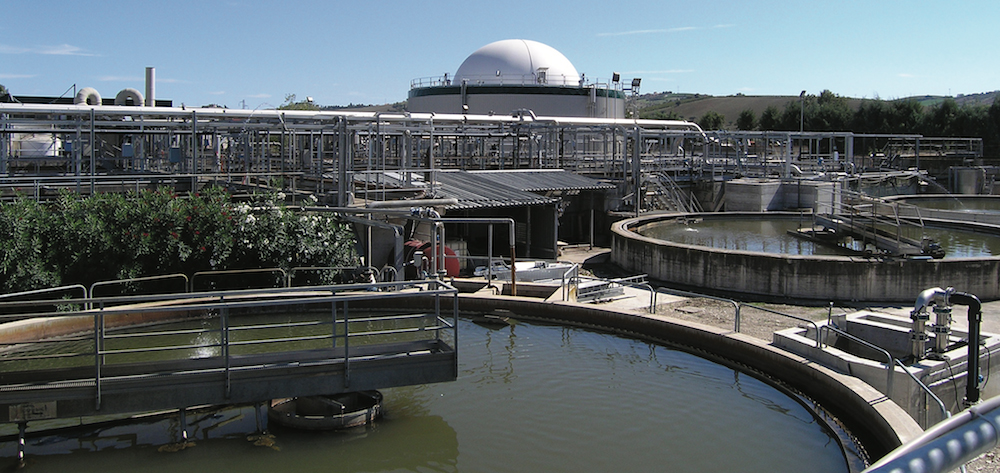
Waste-to-energy is an important technology that can help companies become more sustainable not only by reducing waste volume, but also by producing gas that can be reused at the plant or used for generating electricity, which can offset operational costs and even be sold back to the grid. While these incentives are significant, adopting waste-to-energy doesn’t address all environmental issues and unfortunately, does introduce new challenges.
Through anaerobic digestion, waste-to-energy technology is applied across a range of industries to extract biogas — a mixture of methane and carbon dioxide — from organic wastes. Digestate, a byproduct of the anaerobic digestion process, is a stable fermented waste that is often used as a fertilizer.
Organic wastes from food and beverage processing are particularly suitable for waste-to-energy treatment. Waste streams may include process wastewater, whey, primary sludge from wastewater pretreatment, and manure, as well as many other biosolids.
The Challenges of Waste-to-Energy Technology
One of the most critical issues facing waste-to-energy treatment is the high concentration of hydrogen sulfide in the produced biogas, and the nitrogen content in the digestate.
Removing Corrosive Hydrogen Sulfide
Fabio Poletto, RWL Water Sales Engineer, sat down with Water Online to shed light on the problem at hand:
Biogas produced in certain applications (paper mills, candied fruit producers, jam producers) is very rich in hydrogen sulfide, which is corrosive for boilers and cogenerators. Usually, biogas is desulfurized with alkaline washing in a scrubber column. This solution is very effective […] but it consumes a great amount of sodium hydroxide.
To address this issue, RWL Water utilizes a process that effectively transfers the hydrogen sulfide to the washing solution, which consumes a portion of the alkalinity. Moreover, an oxidation process allows the sulfur to be removed, restoring the solution to its original alkalinity. Poletto emphasizes the technology’s profitable and eco-friendly attributes:
RWL Water’s solution is the most cost effective and environmentally friendly. It enables […] a high removal yield typical for washing scrubbers and greatly reduces consumption of sodium hydroxide
Treating Excess Nitrogen in the Digestate
An additional challenge is the high nitrogen content often found in the digestate. When the digestate is applied onto farmland, this nitrogen can create environmental problems, particularly on land prone to runoff.
In food and beverage waste streams, the nitrogen may be found in both solid and liquid form. It may also be present in compounds such as struvite, or in the form of ammonium bicarbonate in solutions. Poletto goes on to state:
Instead of disposing the digestate on farmland as is, the liquid can be separated and treated. Treatment can occur in a nitrification-denitrification or nitrosation plant, or in a stripping system with the recovery of ammonium phosphate.
These processes contribute to reduce nitrogen concentration by 30 to 50 percent. RWL Water developed the nitrosation process to reduce the amount of ammonia in concentrated wastes, which lowers both the energy demand and the cost of biogas production.
Efficient, Sustainable Solutions for Challenging Waste Streams
When combined with other technologies, waste-to-energy treatment and biogas production can be very cost-effective and environmentally friendly while creating new revenue opportunities, even for difficult-to-treat waste streams such as those from slaughterhouses.
Because effluents vary greatly from facility to facility, there is no standard solution for the treatment of wastewater from food and beverage industries — a custom configuration is needed.
Slaughterhouse Waste
With decades of experience, RWL Water has developed unique solutions for the treatment of slaughterhouse waste in order to maximize process efficiency and minimize operating costs.
Wastewater is initially treated using dissolved air flotation (DAF), which removes as much as 80 percent of the organic load and 65 percent of the nitrogen load. The sludge is then treated with an anaerobic digestion process capable of treating effluent streams with very high nitrogen concentration.
Once anaerobic digestion is complete, the solid and liquid digestate are separated. The solids — about 20 percent of the incoming waste — can be used as a fertilizer while the liquid is sent to a wastewater treatment plant along with the clarified water from the dissolved air flotation stage.
The wastewater treatment uses a double-stage nitrification-denitrification process that reduces the chemical oxygen demand to less than 100 mg/L and the total nitrogen level to less than 20 mg/L. If equipped with a nitrosation pre-treatment system, the operational costs can be further reduced.
For more insights into effective and efficient waste-to-energy facilities, you can read the full Water Online interview with Fabio Poletto. Or contact us with any questions about waste-to-energy, or to discuss your next water, wastewater, or energy challenge.
